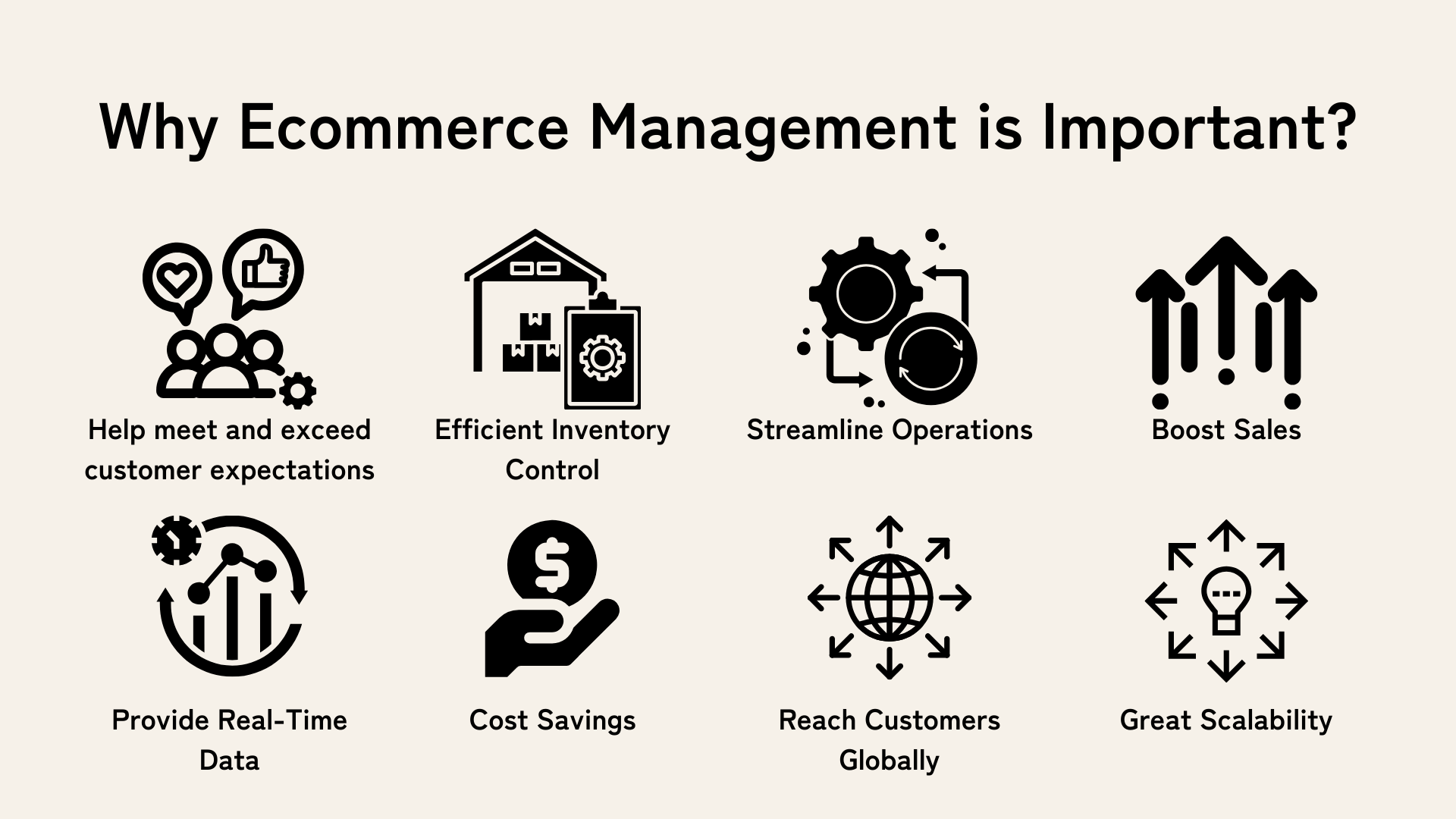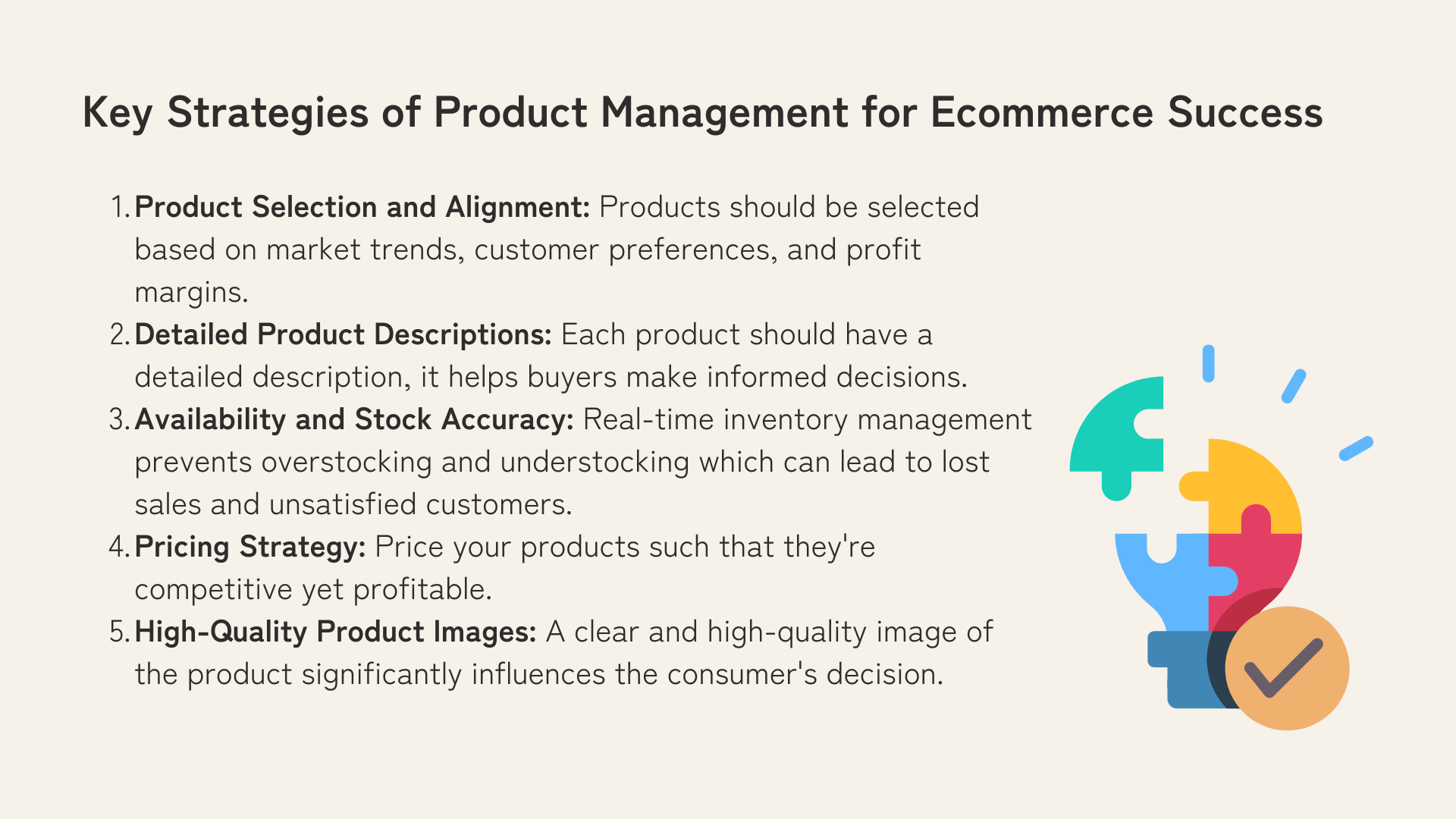Introduction
You have recently launched an ecommerce business or are considering starting one.
Effective management strategies are crucial for success, but with so much to learn, you may feel overwhelmed.
This comprehensive guide breaks down key areas of ecommerce management into clear, actionable steps for beginners.
With insights drawn from experienced ecommerce professionals, it covers everything from developing products to managing inventory to driving traffic and conversions.
Whether you need foundational knowledge or a refresher on best practices, you will learn pragmatic tips for building and managing a profitable online store.
Follow along as we demystify the components of running an efficient ecommerce operation.
Understanding Ecommerce Management
To effectively manage an ecommerce business, you must have a solid understanding of key areas and how they intersect.
Ecommerce management refers to the administration and oversight of a company's online sales operations and processes.
It involves developing and executing strategies to attract customers, drive sales, and ensure a positive customer experience.
As an ecommerce manager, your role is to optimize all aspects of the online shopping experience. You will oversee website design and development, digital marketing campaigns, customer service, order fulfillment, and data analysis.
Having a comprehensive view of the ecommerce landscape will allow you to make strategic decisions that boost key metrics like conversion rates, average order value, and customer lifetime value.

Key Areas of Ecommerce Management
To effectively manage an ecommerce business, you must focus on several key areas.
Website Management
At the heart of any ecommerce business is its website. As an ecommerce manager, you must ensure your site is visually appealing, easy to navigate, mobile-friendly, and optimized for search engines.
Monitor site performance and make improvements to page load times, forms, checkout processes, and product pages.
Stay up-to-date with web design trends and new features that can enhance the customer experience.
Product Selection and Pricing
Choosing the right products to sell and setting competitive prices are fundamental to success.
Analyze your target market and competitors to determine high-demand goods with strong profit potential.
Focus on a specific product category or niche to build expertise. Price items affordably while still generating an acceptable margin.
Occasionally re-evaluate pricing and make adjustments as needed based on the latest market conditions and costs.
Marketing and Promotion
Employ multi-channel marketing strategies to reach customers, increase website traffic, and boost sales.
Use techniques like search engine optimization, social media advertising, email campaigns, influencer collaborations, and affiliate partnerships.
Create promotions like coupons, giveaways, bundles, flash sales, and loyalty programs. Build an active social media presence and start a blog or newsletter to engage your audience.
Order Fulfillment and Shipping
Develop an efficient system to fill customer orders, pack and ship items, and provide tracking information.
Choose a shipping carrier based on delivery speed, cost, and locations serviced. Consider offering free shipping to increase conversion rates.
Make returns as convenient as possible to provide good customer service. Monitor key performance indicators like order accuracy, shipping times, and return rates to identify areas for improvement.
Customer Service
Providing high quality customer service is essential for ecommerce success. You will establish policies and procedures to assist customers before, during, and after a sale.
Provide helpful and responsive customer service across multiple communication channels.
Answer questions, address issues, process returns, and manage complaints promptly and professionally.
Use a ticketing system to keep track of support requests and monitor response times.
Survey customers regularly to determine satisfaction levels and make changes accordingly. Strong customer service will build brand loyalty and word-of-mouth promotion.
Analytics and Optimization
Review key metrics and analytics to better understand customer behavior, spot trends, and make data-driven decisions.
Track metrics like traffic, conversions, average order value, and customer acquisition cost.
Use A/B testing to optimize your website and marketing campaigns. Analyze sales reports, search rankings, and social media insights.
Continually improve the user experience and conversion rates through ongoing testing and refinement.
With diligent focus on these critical areas, you can achieve sustainable success and growth in ecommerce management.
But remember, in the rapidly changing world of online retail, ongoing learning and adaptation are required.
Stay up-to-date with the latest digital commerce technologies, strategies, and best practices.
Ecommerce Management Best Practices
#1 Product Management for Ecommerce Success
To achieve success in ecommerce, effective product management is essential. As an ecommerce manager, you must optimize your product selection, information, and inventory to maximize sales and customer satisfaction.
Carefully curate your product selection to focus on items that match your target customers' needs and interests.
Analyze sales data and customer reviews to determine which products are most in-demand and profitable.
Remove underperforming products to avoid wasted resources. Continually search for new, innovative offerings to keep your selection up-to-date with current trends.
Provide detailed descriptions, high-quality images, and multimedia for each product. Include all relevant details about the product specifications, dimensions, materials, and features.
Well-presented product information builds customer confidence and helps facilitate purchases. Include a consistent and logical structure for product pages across your site.
Maintain sufficient inventory levels to meet customer demand, while avoiding excess surplus.
It’s perceived that poor inventory management costs retailers $1.75 trillion annually.
Use sales forecasts and historical data to determine appropriate stock amounts for each product.
Track inventory daily and reorder as needed to prevent stockouts. Work with vendors and suppliers to negotiate favorable purchasing terms and ensure reliable delivery.
Effective ecommerce product management requires organization, analytical skills, and strategic thinking.
By focusing on optimizing your product selection, product information, and inventory management, you can achieve sustainable success and growth.
Monitor key performance indicators like conversion rates, customer reviews, and sales to determine opportunities for continual improvement.
Keep learning and adapting to changes in technology, marketing techniques, and customer preferences.

#2 Optimizing the User Experience and Interface
A well-designed user experience (UX) and interface (UI) is crucial for any ecommerce business.
As an ecommerce manager, you need to focus on creating an intuitive experience that keeps customers engaged and guides them smoothly through the purchase process.
Streamline the checkout process
The checkout process should be as quick and simple as possible. Only ask for necessary information, use clear labeling and minimize the number of steps.
Offering a guest checkout option and saved payment info can also speed up the process for repeat customers.
Optimize for mobile
With more and more shopping happening on mobile devices, your ecommerce site needs to be fully optimized for smaller screens.
Ensure buttons and links are large enough to tap, minimize horizontal scrolling, and consider using a responsive design that adapts to different devices.
A mobile app can also provide an enhanced experience for your customers.
Include high-quality images
High-resolution product images are essential for giving customers a sense of what they're buying. Include multiple images showing the product from different angles, as well as any available size or style options.
For clothing and accessories, images of the product on a model can also be helpful.
Use filters and search
Make it easy for customers to find what they need by offering robust search and filtering options.
Filter by attributes like price, brand, color, and size. Also, allow users to sort results in different ways, such as by newest, bestselling or highest rated.
Offer recommendations
Recommendation engines use data about a customer's browsing and purchase history to suggest other products they may be interested in.
Recommendations help expose customers to more of your catalog and increase the likelihood of additional sales.
Test and optimize
The only way to truly know if your UX and UI are effective is through testing and optimization.
Use web analytics tools to see how customers are interacting with your site and where drop-off rates are highest.
You can also conduct user testing to get direct feedback. Make changes to improve the experience, then test again to measure the impact.
Continual testing and optimization is key to ecommerce success.
#3 Digital Marketing and SEO for Ecommerce
To drive traffic and sales for your ecommerce business, focusing on digital marketing and search engine optimization (SEO) is crucial.
SEO helps improve your visibility in search engines like Google, allowing potential customers to find your online store.
Optimize Your Product Pages
Having optimized product pages is key to higher rankings in search results. Include high-quality product images and well-written descriptions with relevant keywords.
The page title, meta description, and headers should also contain keywords. Keep your content concise while highlighting the key features and benefits.
Blogging and Content Creation
Creating helpful content like blog posts, videos, and images establishes you as an authority in your industry.
Write about topics that would interest your target customers. Embed keywords naturally throughout your content.
The more high-quality content you publish, the more opportunities there are for people to find your site.
Technical SEO
There are several technical aspects to SEO you need to consider:
- A fast, mobile-friendly website. Google favors fast, responsive sites. Strong internal linking. Link to other relevant content on your site.
- Proper page titles and meta descriptions. These appear in search results and should be optimized.
- XML sitemaps. Submit sitemaps to Google Search Console to help them crawl your site.
- Robust product schema markup. Add structured data to your product pages to enhance how they appear in search.
- Minimal 404 errors. Fix or redirect any broken links on your site.
- Secure site. Use HTTPS to encrypt communications between your site and visitors. Google gives a ranking boost to secure sites.
Conversion Tracking
To optimize your SEO and marketing efforts, you need to track how visitors convert on your site.
Install tools like Google Analytics, Google Ads, and Google Merchant Center to monitor metrics such as:
- Bounce rate - The percentage of visitors who leave your site after viewing only one page. A lower bounce rate is better.
- Pages per session - The average number of pages viewed during a visit. A higher number indicates visitors are more engaged.
- Conversions - The number of desired actions completed, such as purchases, signups, or downloads. Track which marketing channels drive the most conversions.
- Return on investment - Calculate how much revenue is generated from your marketing investments. Make data-driven decisions to improve ROI over time.
With a comprehensive approach to digital marketing and SEO, you can reach more potential customers, drive traffic to your ecommerce site, and boost online sales.
Do you want to learn more about Ecommerce SEO? Read “**Ecommerce SEO: A Comprehensive Guide for Beginners” for better understanding of Ecommerce SEO!**
Are you in search of an all-in-one ecommerce management solution? Look no further!
Sanka is the ultimate CRM platform created specifically to help grow your ecommerce business.
From inventory management, marketing automation to customer service solutions, Sanka's got you covered.
Streamline your operations with unlimited users and integrations, available at a competitive price point.
Trusted by over a thousand clients, Sanka's platform empowers businesses of all sizes to achieve their ecommerce goals.
Start your free trial today and propel your business to new heights with Sanka - the must-have for ecommerce managers. Learn More and Start Your Free Trial
Conclusion
To effectively manage your ecommerce business, you must stay organized, understand your financials, optimize your processes, and keep your customers happy.
By diligently tracking metrics, streamlining operations, providing good support, and keeping up with ecommerce best practices, you can gain control over this complex but rewarding endeavor.
The principles discussed will guide any entrepreneur to competency. With dedication and an eye toward continuous improvement, your online store can thrive.
Now equipped with fundamental knowledge, you have tools to build a successful ecommerce management strategy.








